Text Based Maze Game using Java Programming Language
VerifiedAdded on 2022/11/17
|19
|1742
|109
AI Summary
This project implements the text based maze game using java programming language. It contains player’s character, weapons, item details, score and attacking character. The game is based on the dungeons and dragons role paying system. The game has certain rules for playing the game. Each character has different weapons and characters wear armour. The players attack other players by using the weapons. Non players have character and additional attributes that are conservation and hostile to the other players. The game has successfully implemented the maze game using java programming language. It is based on the dungeons and dragon’s game developed by using java programming language.
Contribute Materials
Your contribution can guide someone’s learning journey. Share your
documents today.
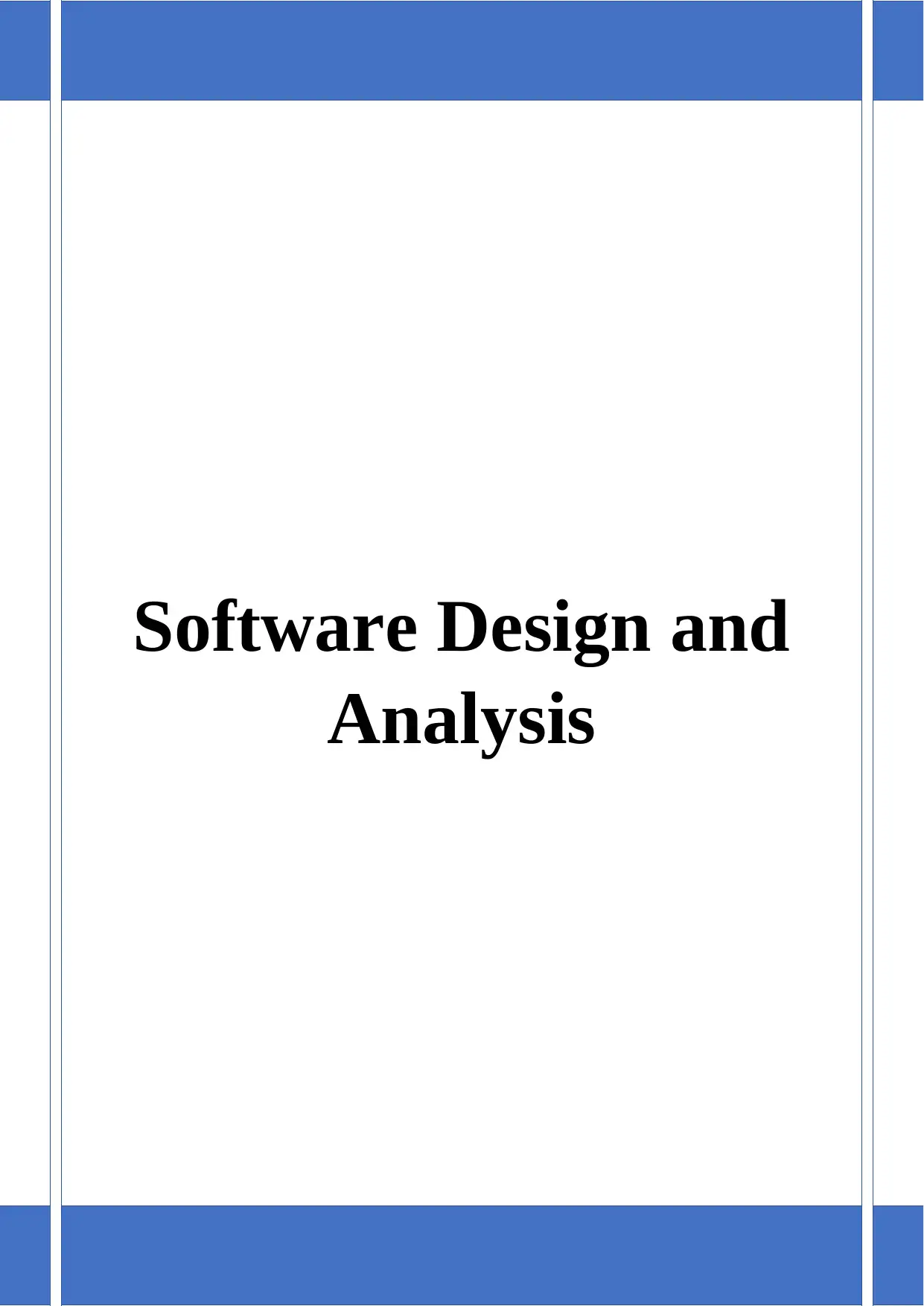
Software Design and
Analysis
Analysis
Secure Best Marks with AI Grader
Need help grading? Try our AI Grader for instant feedback on your assignments.
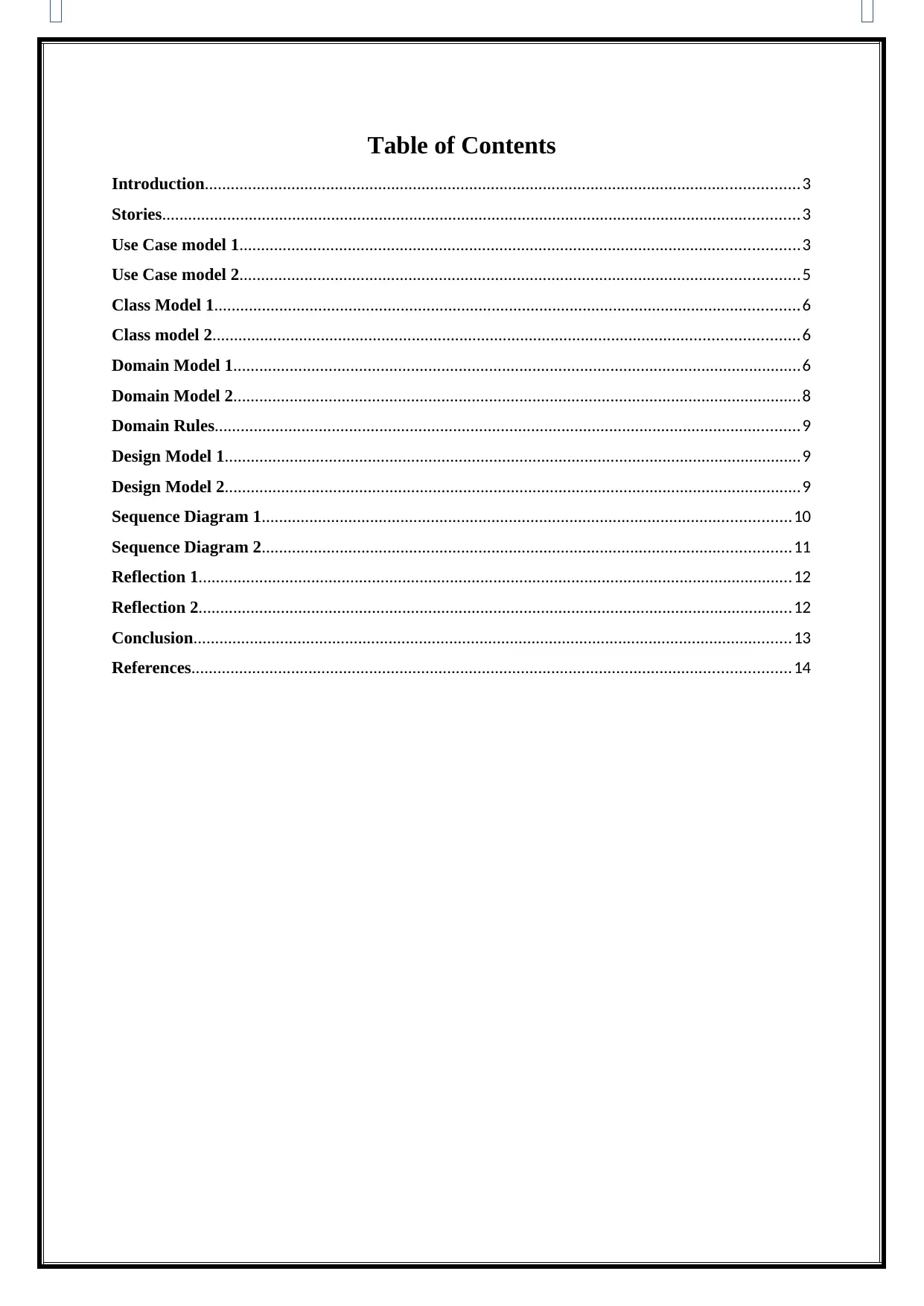
Table of Contents
Introduction.........................................................................................................................................3
Stories...................................................................................................................................................3
Use Case model 1.................................................................................................................................3
Use Case model 2.................................................................................................................................5
Class Model 1.......................................................................................................................................6
Class model 2.......................................................................................................................................6
Domain Model 1...................................................................................................................................6
Domain Model 2...................................................................................................................................8
Domain Rules.......................................................................................................................................9
Design Model 1.....................................................................................................................................9
Design Model 2.....................................................................................................................................9
Sequence Diagram 1..........................................................................................................................10
Sequence Diagram 2..........................................................................................................................11
Reflection 1.........................................................................................................................................12
Reflection 2.........................................................................................................................................12
Conclusion..........................................................................................................................................13
References..........................................................................................................................................14
Introduction.........................................................................................................................................3
Stories...................................................................................................................................................3
Use Case model 1.................................................................................................................................3
Use Case model 2.................................................................................................................................5
Class Model 1.......................................................................................................................................6
Class model 2.......................................................................................................................................6
Domain Model 1...................................................................................................................................6
Domain Model 2...................................................................................................................................8
Domain Rules.......................................................................................................................................9
Design Model 1.....................................................................................................................................9
Design Model 2.....................................................................................................................................9
Sequence Diagram 1..........................................................................................................................10
Sequence Diagram 2..........................................................................................................................11
Reflection 1.........................................................................................................................................12
Reflection 2.........................................................................................................................................12
Conclusion..........................................................................................................................................13
References..........................................................................................................................................14
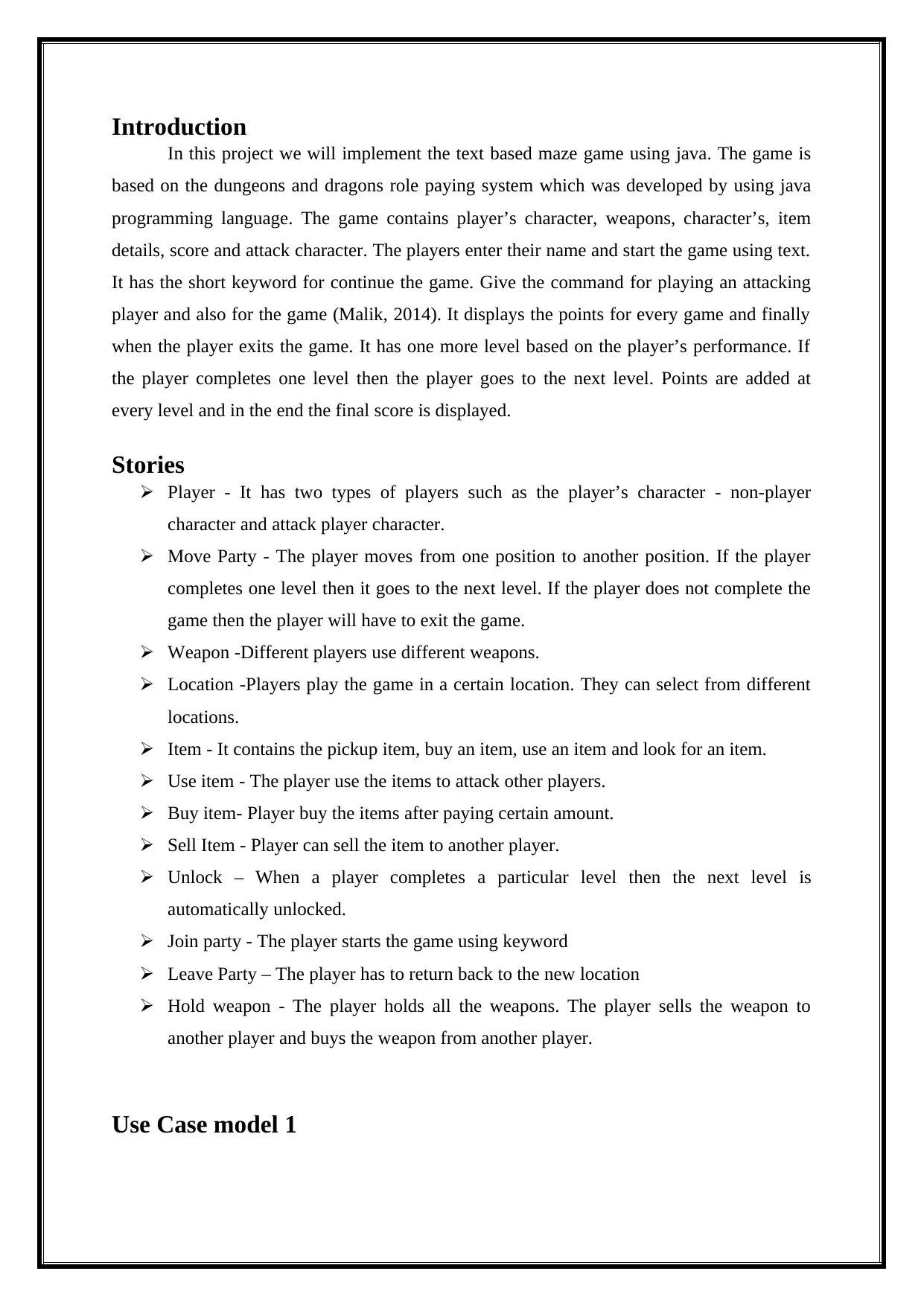
Introduction
In this project we will implement the text based maze game using java. The game is
based on the dungeons and dragons role paying system which was developed by using java
programming language. The game contains player’s character, weapons, character’s, item
details, score and attack character. The players enter their name and start the game using text.
It has the short keyword for continue the game. Give the command for playing an attacking
player and also for the game (Malik, 2014). It displays the points for every game and finally
when the player exits the game. It has one more level based on the player’s performance. If
the player completes one level then the player goes to the next level. Points are added at
every level and in the end the final score is displayed.
Stories
Player - It has two types of players such as the player’s character - non-player
character and attack player character.
Move Party - The player moves from one position to another position. If the player
completes one level then it goes to the next level. If the player does not complete the
game then the player will have to exit the game.
Weapon -Different players use different weapons.
Location -Players play the game in a certain location. They can select from different
locations.
Item - It contains the pickup item, buy an item, use an item and look for an item.
Use item - The player use the items to attack other players.
Buy item- Player buy the items after paying certain amount.
Sell Item - Player can sell the item to another player.
Unlock – When a player completes a particular level then the next level is
automatically unlocked.
Join party - The player starts the game using keyword
Leave Party – The player has to return back to the new location
Hold weapon - The player holds all the weapons. The player sells the weapon to
another player and buys the weapon from another player.
Use Case model 1
In this project we will implement the text based maze game using java. The game is
based on the dungeons and dragons role paying system which was developed by using java
programming language. The game contains player’s character, weapons, character’s, item
details, score and attack character. The players enter their name and start the game using text.
It has the short keyword for continue the game. Give the command for playing an attacking
player and also for the game (Malik, 2014). It displays the points for every game and finally
when the player exits the game. It has one more level based on the player’s performance. If
the player completes one level then the player goes to the next level. Points are added at
every level and in the end the final score is displayed.
Stories
Player - It has two types of players such as the player’s character - non-player
character and attack player character.
Move Party - The player moves from one position to another position. If the player
completes one level then it goes to the next level. If the player does not complete the
game then the player will have to exit the game.
Weapon -Different players use different weapons.
Location -Players play the game in a certain location. They can select from different
locations.
Item - It contains the pickup item, buy an item, use an item and look for an item.
Use item - The player use the items to attack other players.
Buy item- Player buy the items after paying certain amount.
Sell Item - Player can sell the item to another player.
Unlock – When a player completes a particular level then the next level is
automatically unlocked.
Join party - The player starts the game using keyword
Leave Party – The player has to return back to the new location
Hold weapon - The player holds all the weapons. The player sells the weapon to
another player and buys the weapon from another player.
Use Case model 1
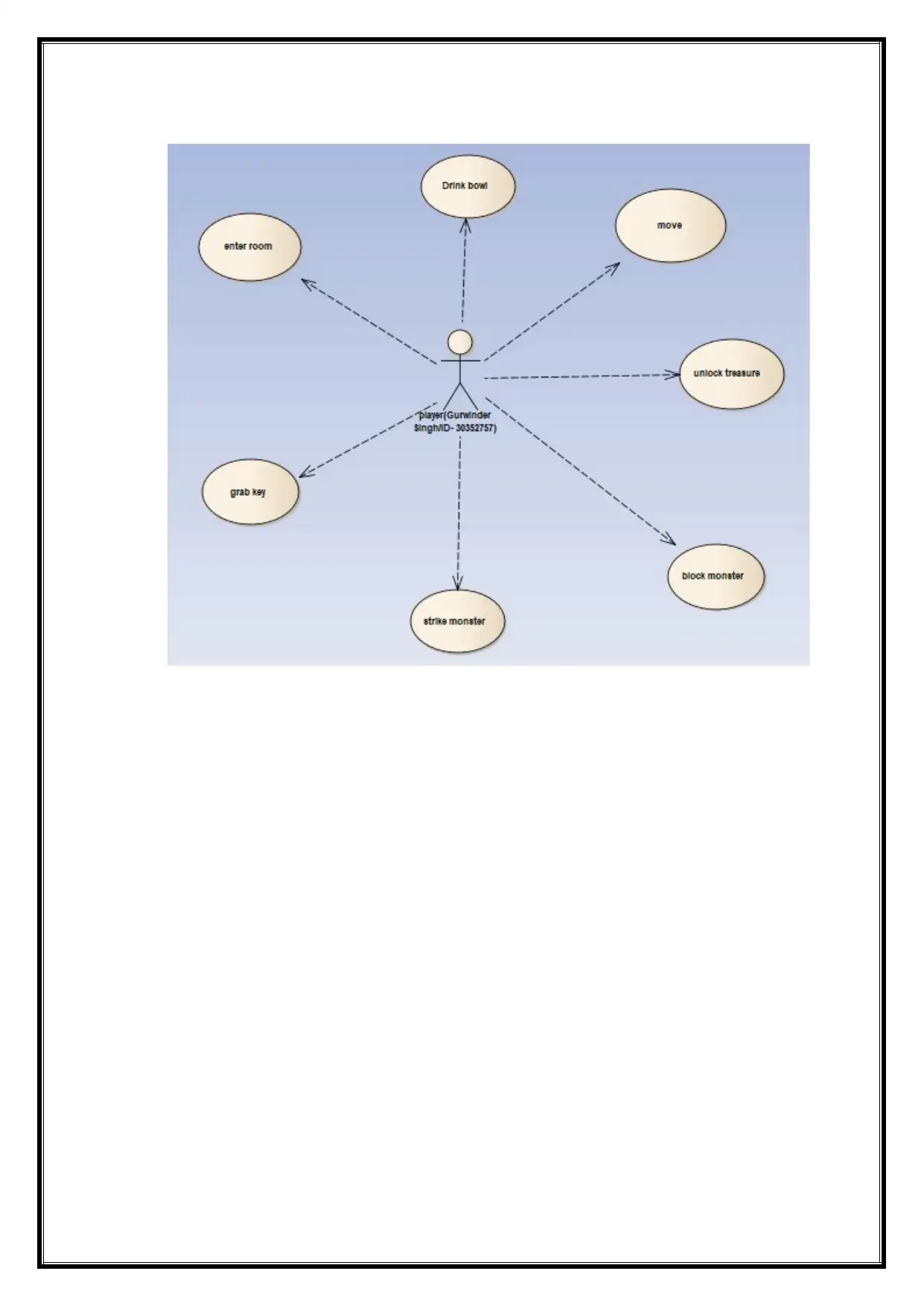
Secure Best Marks with AI Grader
Need help grading? Try our AI Grader for instant feedback on your assignments.
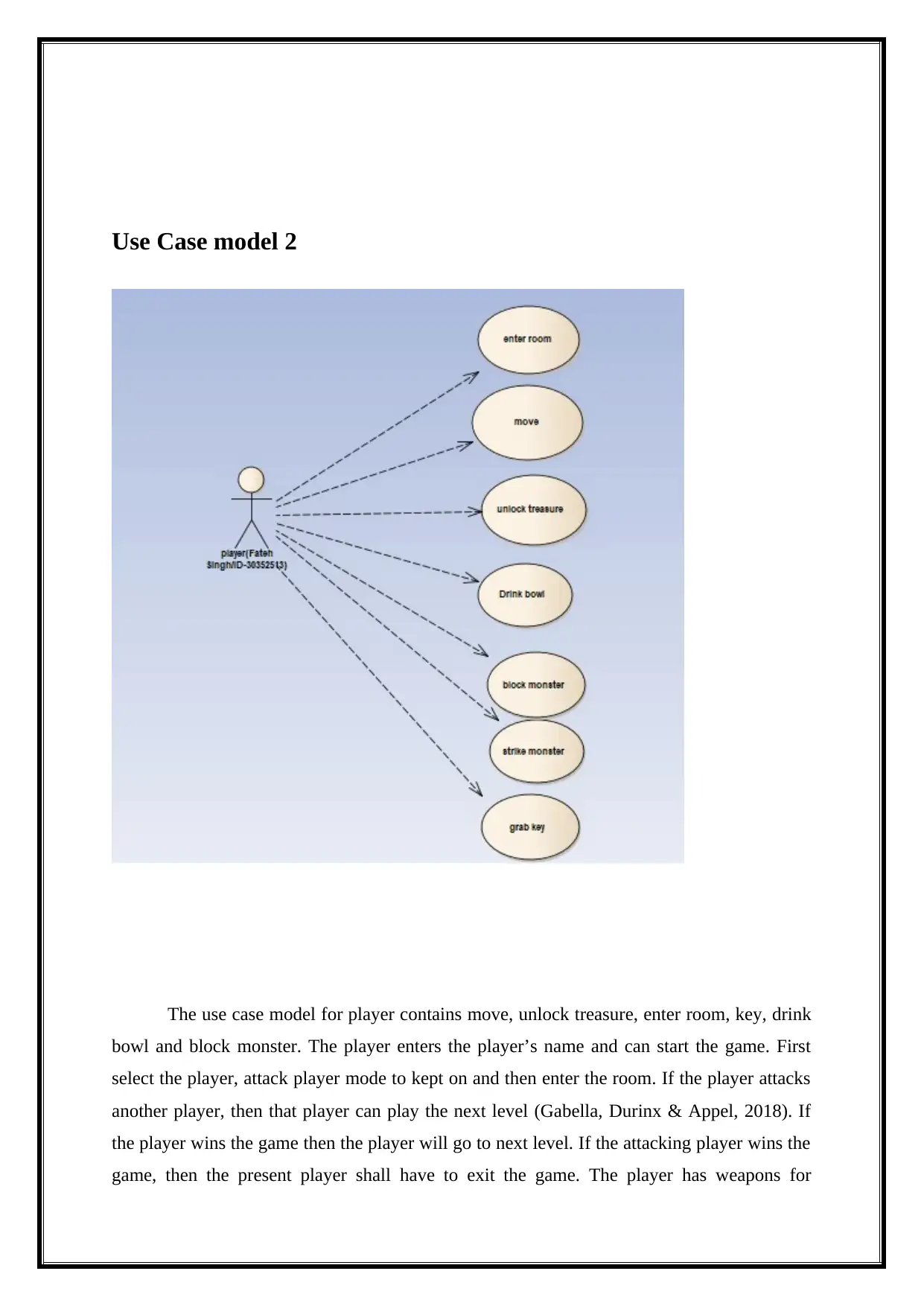
Use Case model 2
The use case model for player contains move, unlock treasure, enter room, key, drink
bowl and block monster. The player enters the player’s name and can start the game. First
select the player, attack player mode to kept on and then enter the room. If the player attacks
another player, then that player can play the next level (Gabella, Durinx & Appel, 2018). If
the player wins the game then the player will go to next level. If the attacking player wins the
game, then the present player shall have to exit the game. The player has weapons for
The use case model for player contains move, unlock treasure, enter room, key, drink
bowl and block monster. The player enters the player’s name and can start the game. First
select the player, attack player mode to kept on and then enter the room. If the player attacks
another player, then that player can play the next level (Gabella, Durinx & Appel, 2018). If
the player wins the game then the player will go to next level. If the attacking player wins the
game, then the present player shall have to exit the game. The player has weapons for
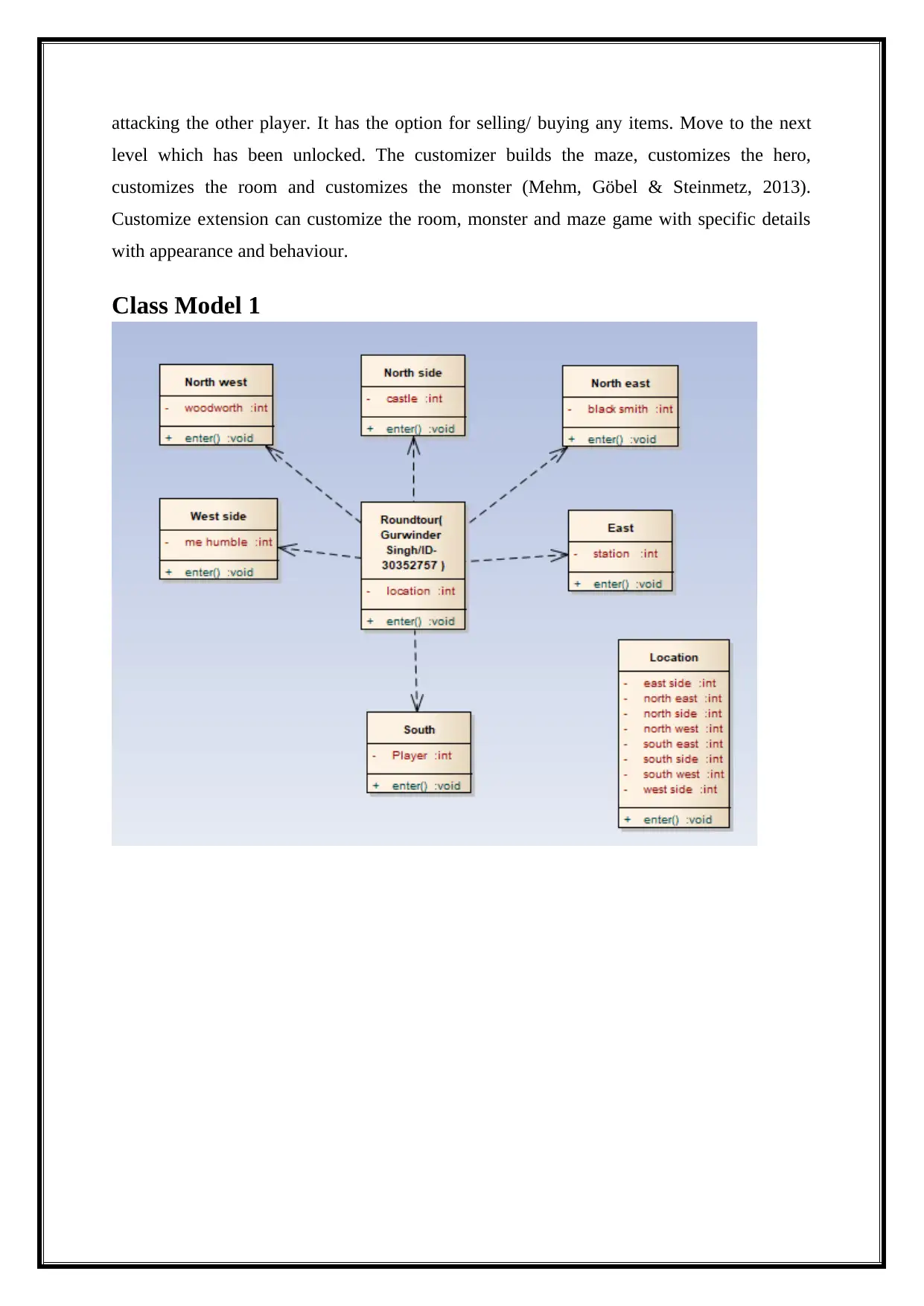
attacking the other player. It has the option for selling/ buying any items. Move to the next
level which has been unlocked. The customizer builds the maze, customizes the hero,
customizes the room and customizes the monster (Mehm, Göbel & Steinmetz, 2013).
Customize extension can customize the room, monster and maze game with specific details
with appearance and behaviour.
Class Model 1
level which has been unlocked. The customizer builds the maze, customizes the hero,
customizes the room and customizes the monster (Mehm, Göbel & Steinmetz, 2013).
Customize extension can customize the room, monster and maze game with specific details
with appearance and behaviour.
Class Model 1
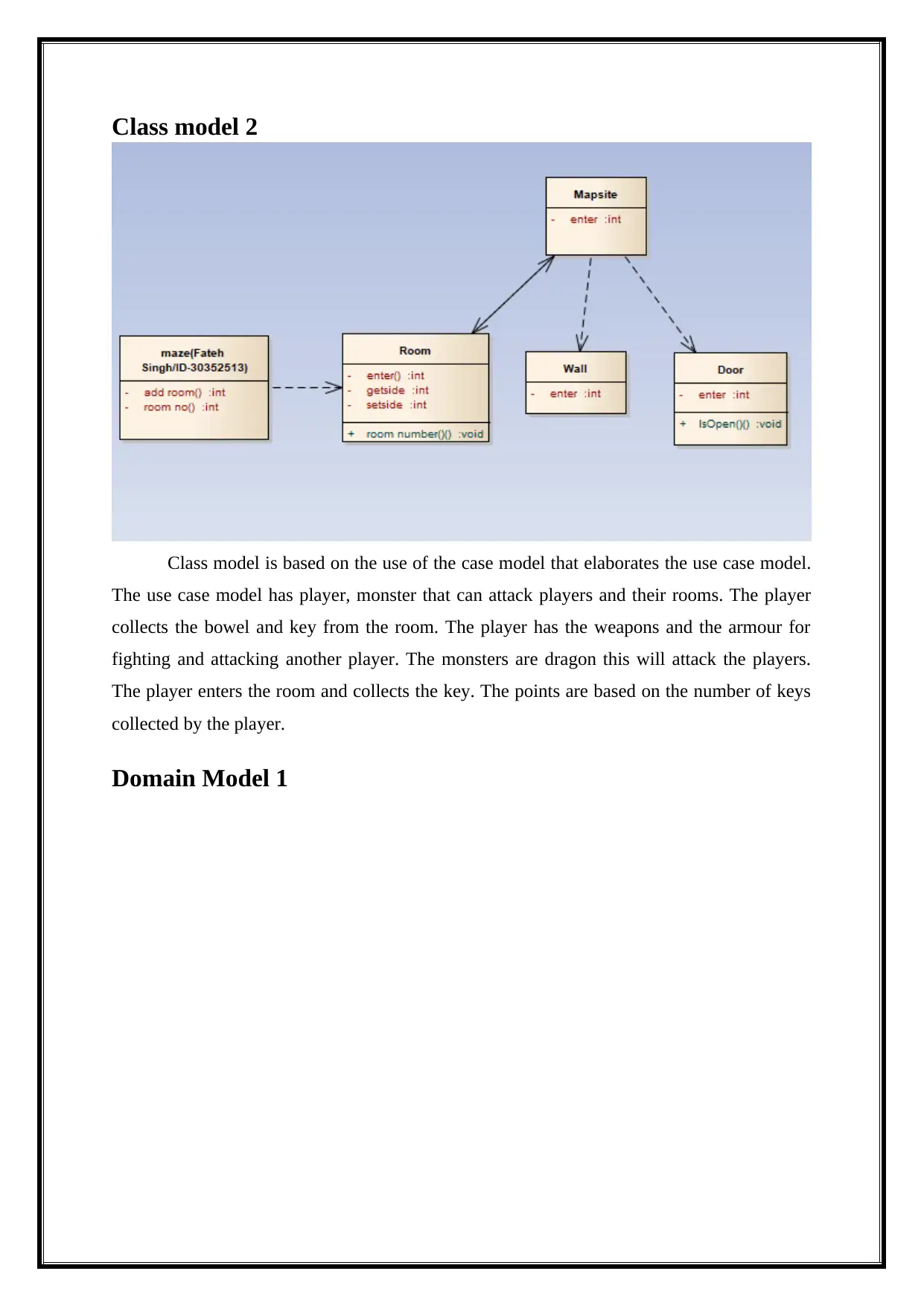
Class model 2
Class model is based on the use of the case model that elaborates the use case model.
The use case model has player, monster that can attack players and their rooms. The player
collects the bowel and key from the room. The player has the weapons and the armour for
fighting and attacking another player. The monsters are dragon this will attack the players.
The player enters the room and collects the key. The points are based on the number of keys
collected by the player.
Domain Model 1
Class model is based on the use of the case model that elaborates the use case model.
The use case model has player, monster that can attack players and their rooms. The player
collects the bowel and key from the room. The player has the weapons and the armour for
fighting and attacking another player. The monsters are dragon this will attack the players.
The player enters the room and collects the key. The points are based on the number of keys
collected by the player.
Domain Model 1
Paraphrase This Document
Need a fresh take? Get an instant paraphrase of this document with our AI Paraphraser
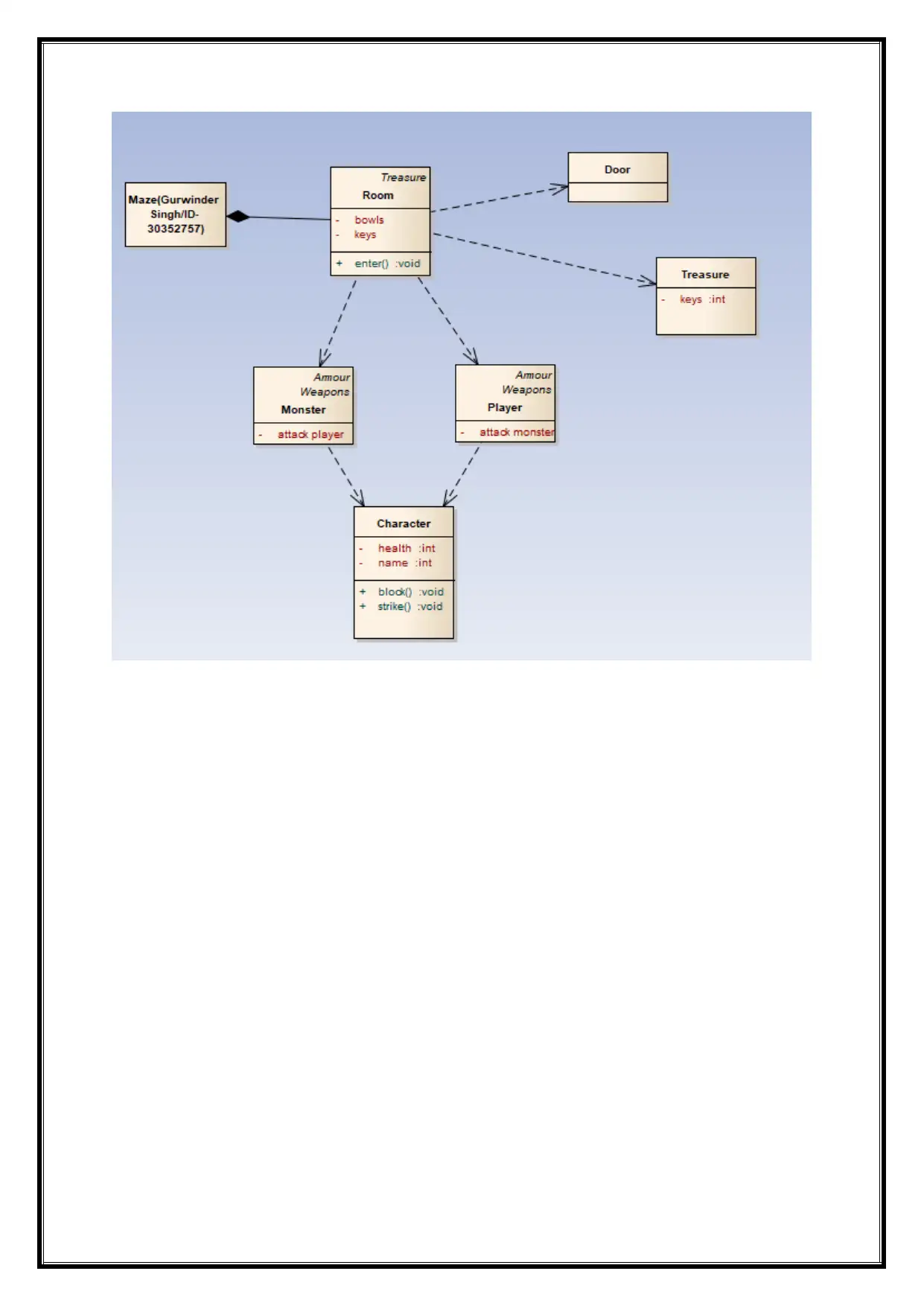
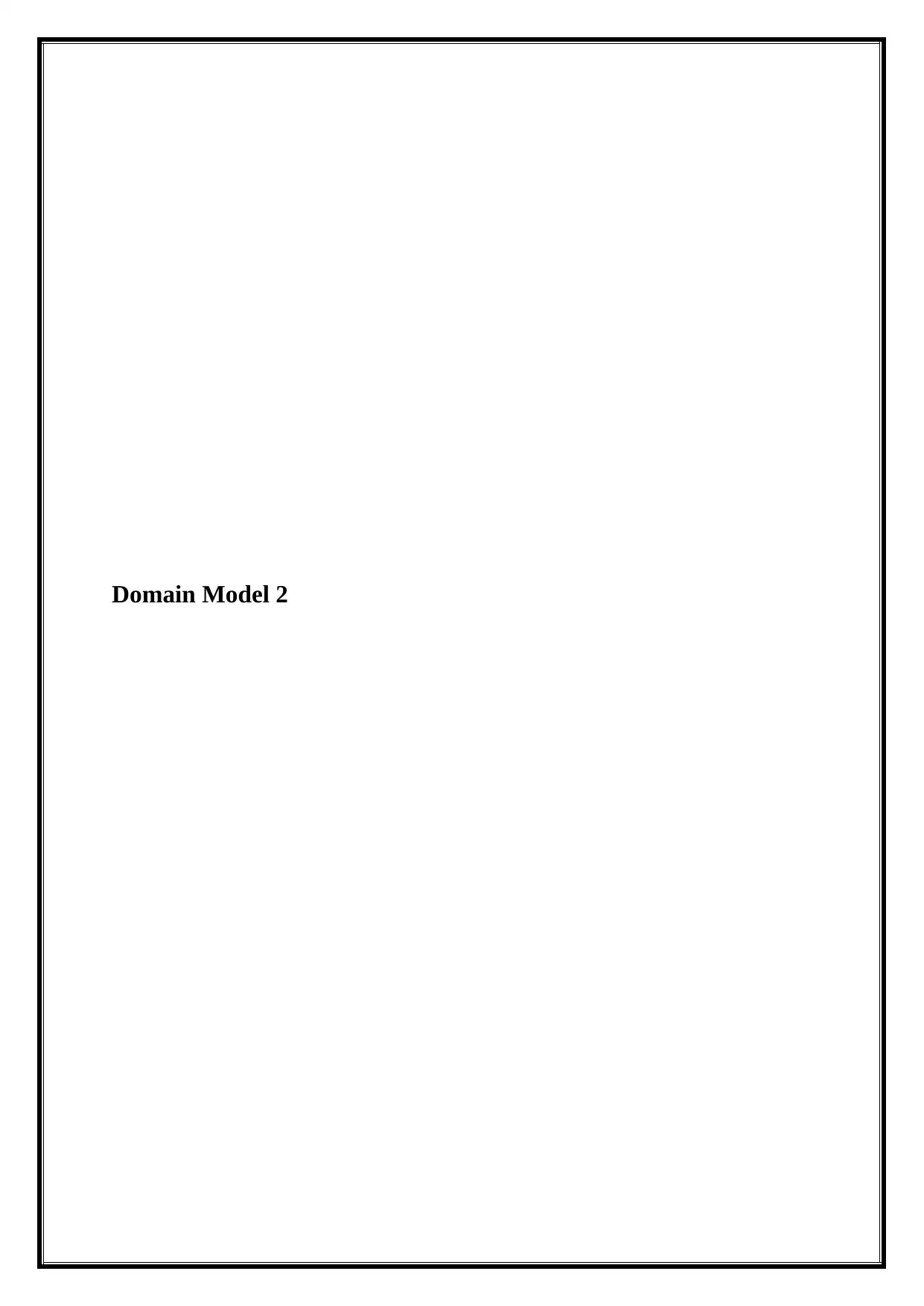
Domain Model 2
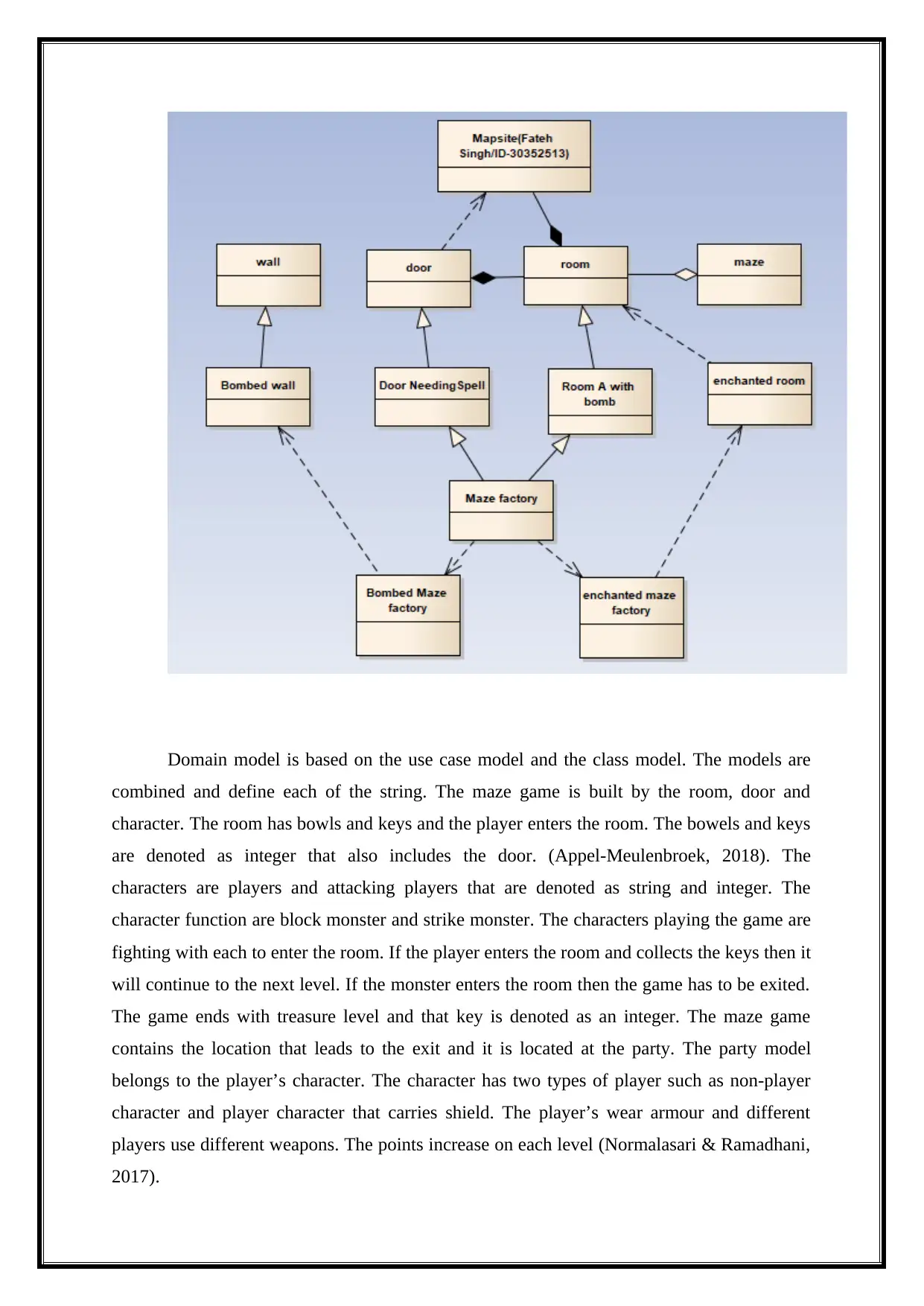
Domain model is based on the use case model and the class model. The models are
combined and define each of the string. The maze game is built by the room, door and
character. The room has bowls and keys and the player enters the room. The bowels and keys
are denoted as integer that also includes the door. (Appel-Meulenbroek, 2018). The
characters are players and attacking players that are denoted as string and integer. The
character function are block monster and strike monster. The characters playing the game are
fighting with each to enter the room. If the player enters the room and collects the keys then it
will continue to the next level. If the monster enters the room then the game has to be exited.
The game ends with treasure level and that key is denoted as an integer. The maze game
contains the location that leads to the exit and it is located at the party. The party model
belongs to the player’s character. The character has two types of player such as non-player
character and player character that carries shield. The player’s wear armour and different
players use different weapons. The points increase on each level (Normalasari & Ramadhani,
2017).
combined and define each of the string. The maze game is built by the room, door and
character. The room has bowls and keys and the player enters the room. The bowels and keys
are denoted as integer that also includes the door. (Appel-Meulenbroek, 2018). The
characters are players and attacking players that are denoted as string and integer. The
character function are block monster and strike monster. The characters playing the game are
fighting with each to enter the room. If the player enters the room and collects the keys then it
will continue to the next level. If the monster enters the room then the game has to be exited.
The game ends with treasure level and that key is denoted as an integer. The maze game
contains the location that leads to the exit and it is located at the party. The party model
belongs to the player’s character. The character has two types of player such as non-player
character and player character that carries shield. The player’s wear armour and different
players use different weapons. The points increase on each level (Normalasari & Ramadhani,
2017).
Secure Best Marks with AI Grader
Need help grading? Try our AI Grader for instant feedback on your assignments.
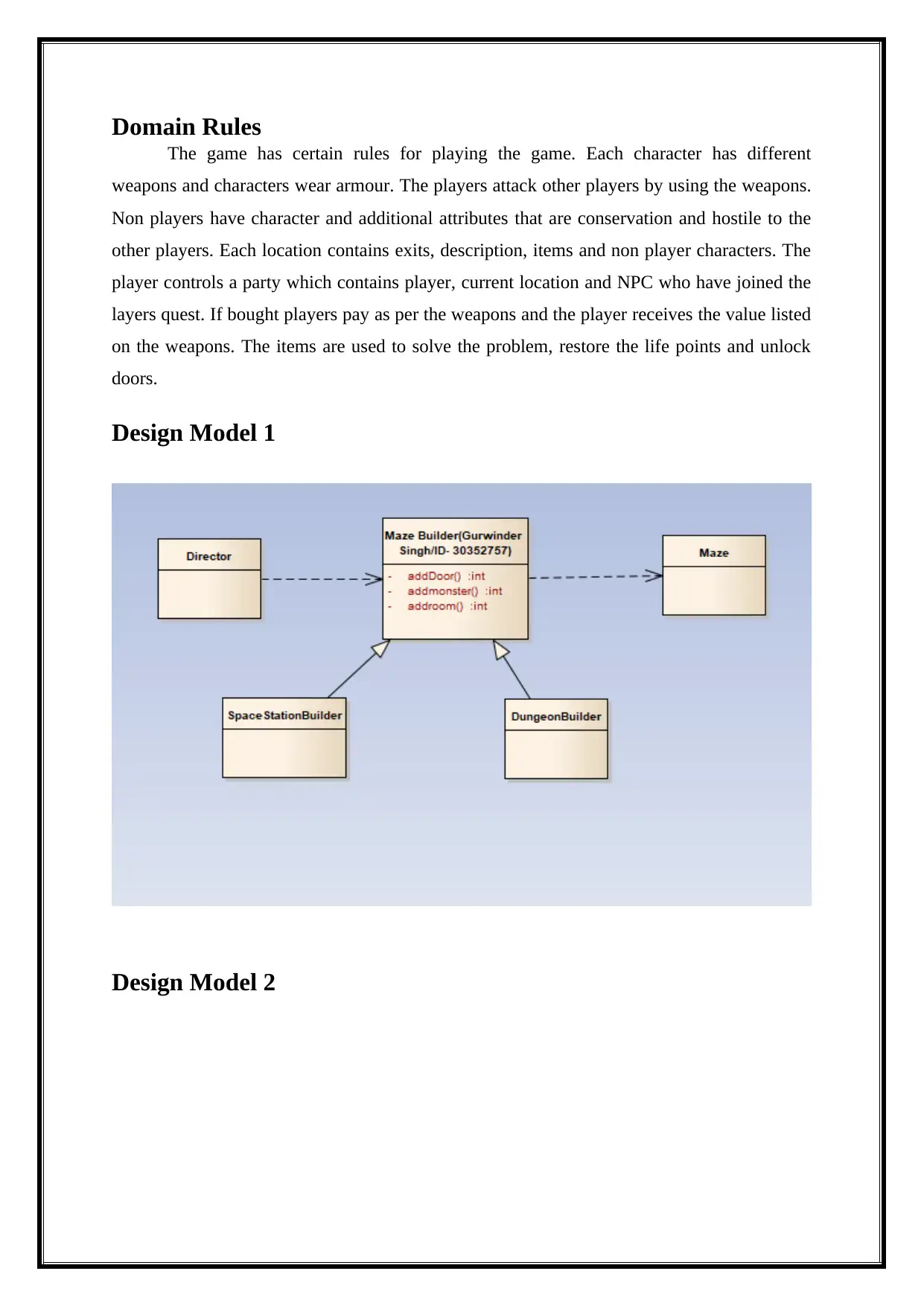
Domain Rules
The game has certain rules for playing the game. Each character has different
weapons and characters wear armour. The players attack other players by using the weapons.
Non players have character and additional attributes that are conservation and hostile to the
other players. Each location contains exits, description, items and non player characters. The
player controls a party which contains player, current location and NPC who have joined the
layers quest. If bought players pay as per the weapons and the player receives the value listed
on the weapons. The items are used to solve the problem, restore the life points and unlock
doors.
Design Model 1
Design Model 2
The game has certain rules for playing the game. Each character has different
weapons and characters wear armour. The players attack other players by using the weapons.
Non players have character and additional attributes that are conservation and hostile to the
other players. Each location contains exits, description, items and non player characters. The
player controls a party which contains player, current location and NPC who have joined the
layers quest. If bought players pay as per the weapons and the player receives the value listed
on the weapons. The items are used to solve the problem, restore the life points and unlock
doors.
Design Model 1
Design Model 2
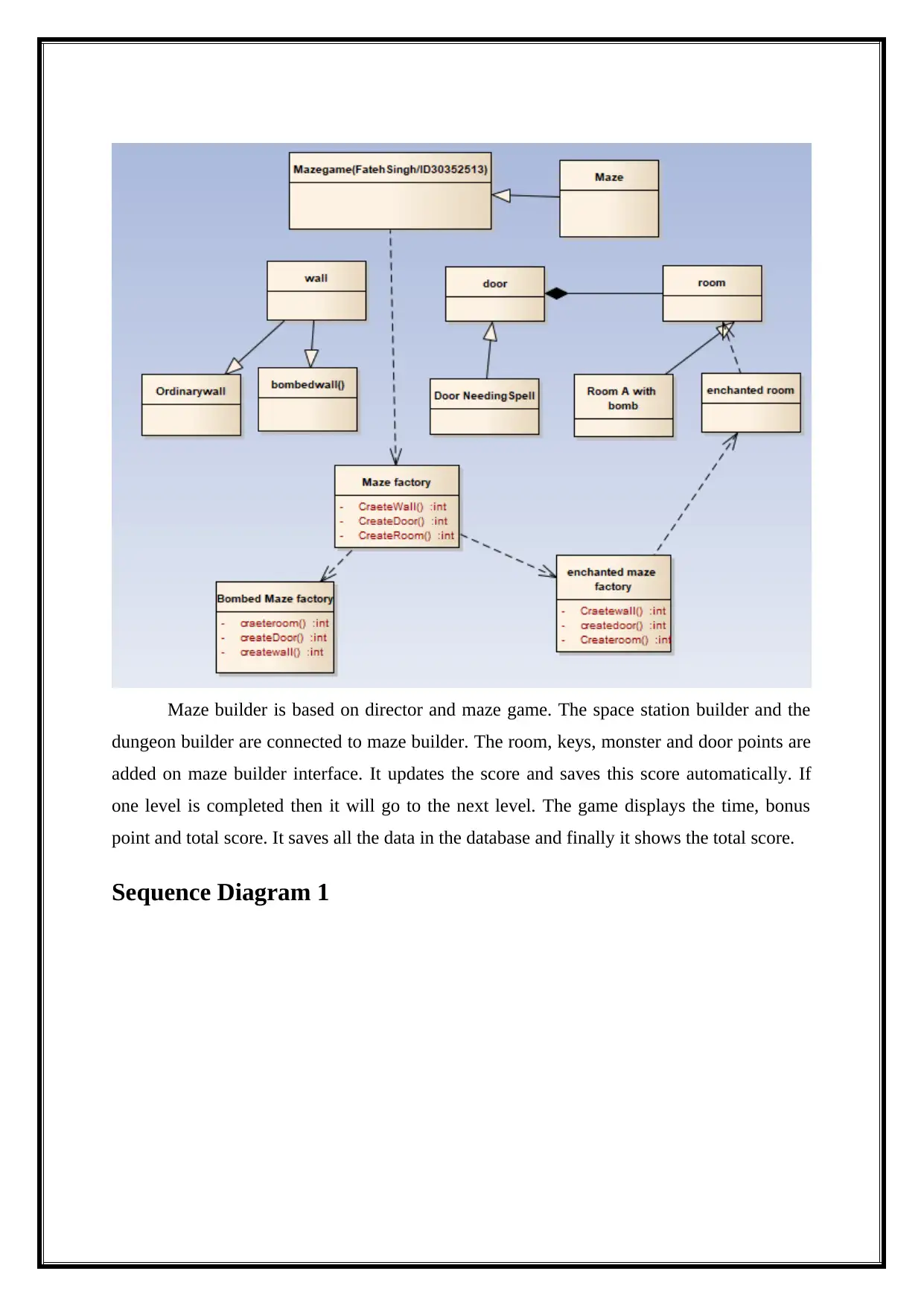
Maze builder is based on director and maze game. The space station builder and the
dungeon builder are connected to maze builder. The room, keys, monster and door points are
added on maze builder interface. It updates the score and saves this score automatically. If
one level is completed then it will go to the next level. The game displays the time, bonus
point and total score. It saves all the data in the database and finally it shows the total score.
Sequence Diagram 1
dungeon builder are connected to maze builder. The room, keys, monster and door points are
added on maze builder interface. It updates the score and saves this score automatically. If
one level is completed then it will go to the next level. The game displays the time, bonus
point and total score. It saves all the data in the database and finally it shows the total score.
Sequence Diagram 1
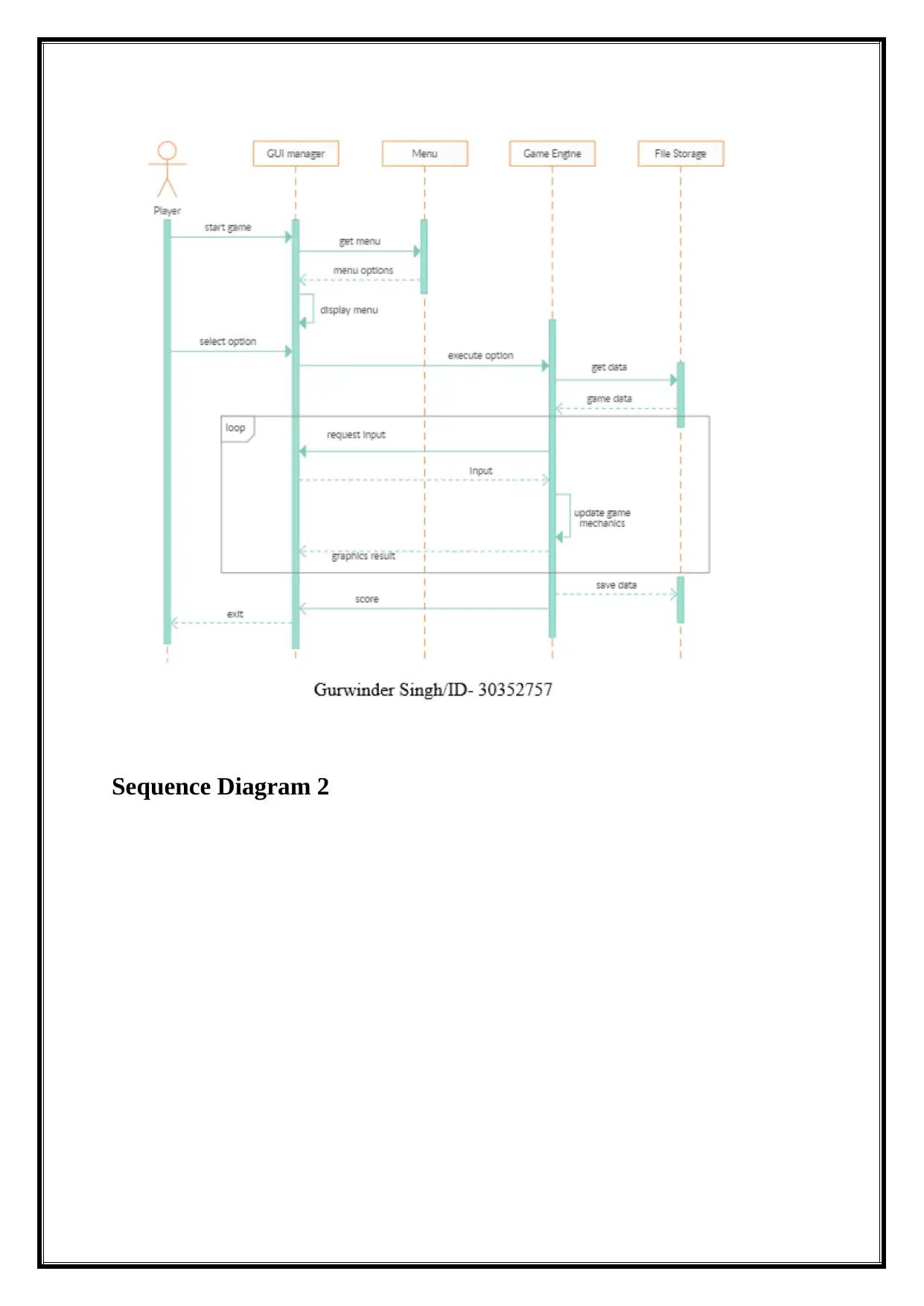
Sequence Diagram 2
Paraphrase This Document
Need a fresh take? Get an instant paraphrase of this document with our AI Paraphraser
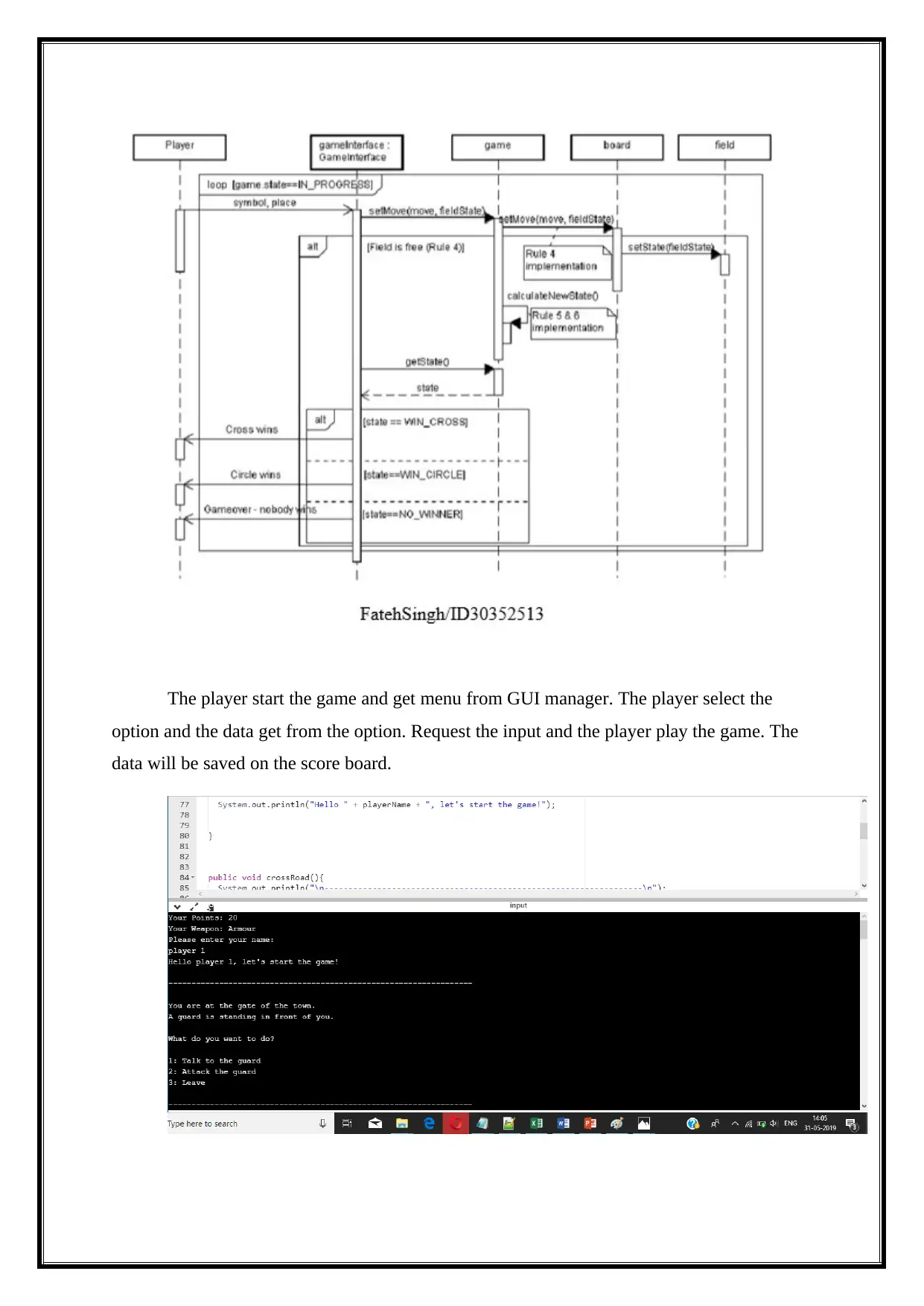
The player start the game and get menu from GUI manager. The player select the
option and the data get from the option. Request the input and the player play the game. The
data will be saved on the score board.
option and the data get from the option. Request the input and the player play the game. The
data will be saved on the score board.
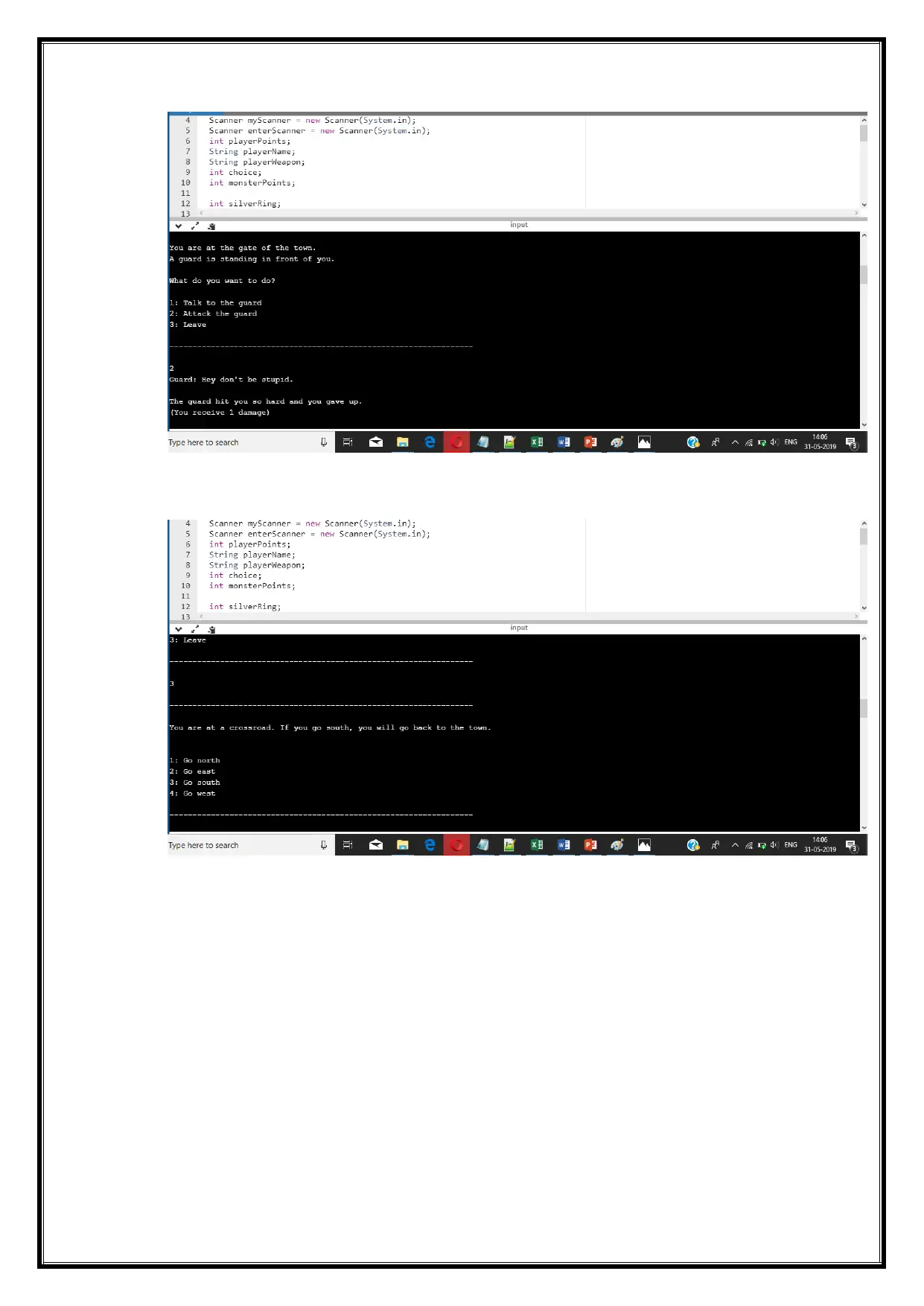
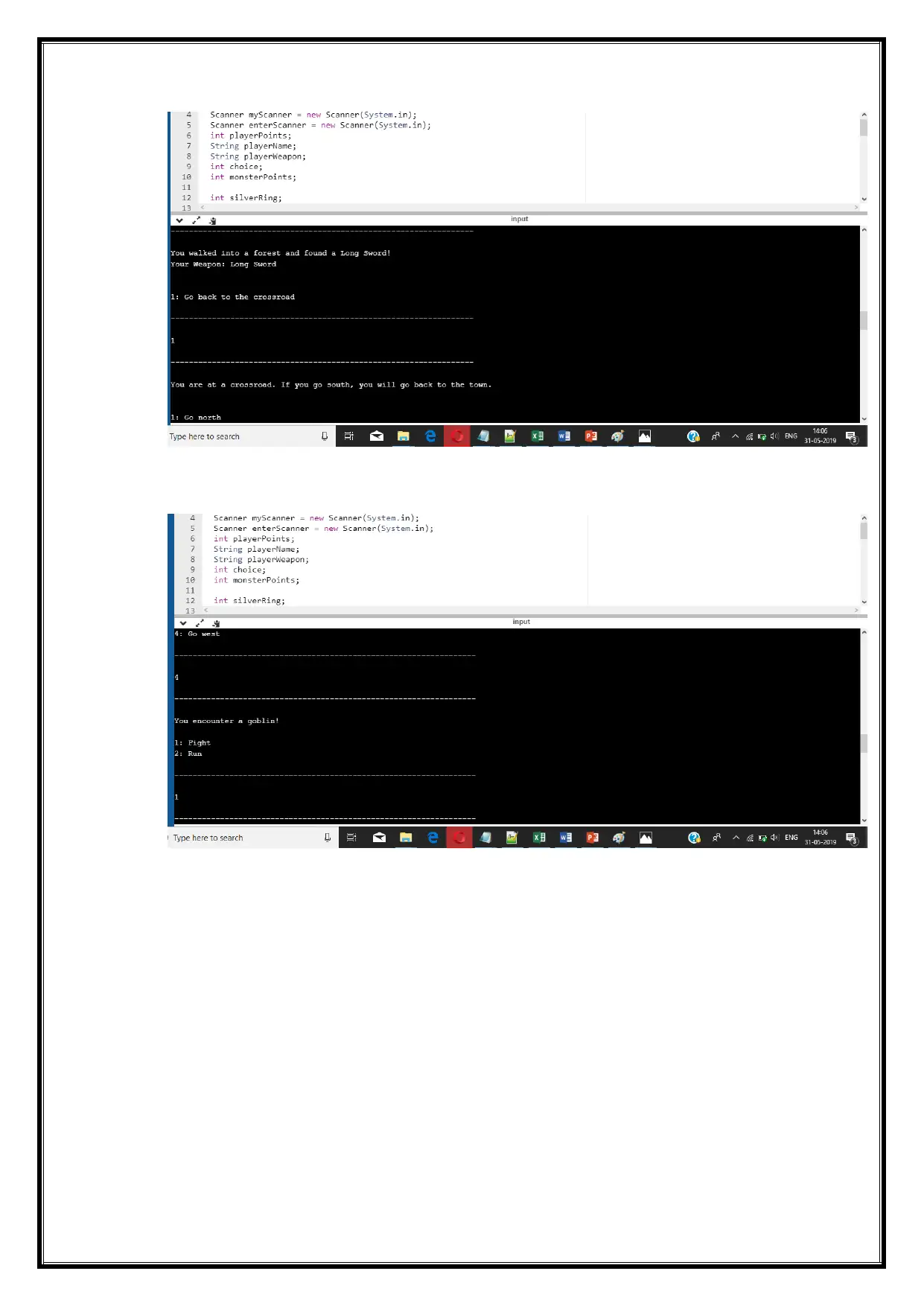
Secure Best Marks with AI Grader
Need help grading? Try our AI Grader for instant feedback on your assignments.
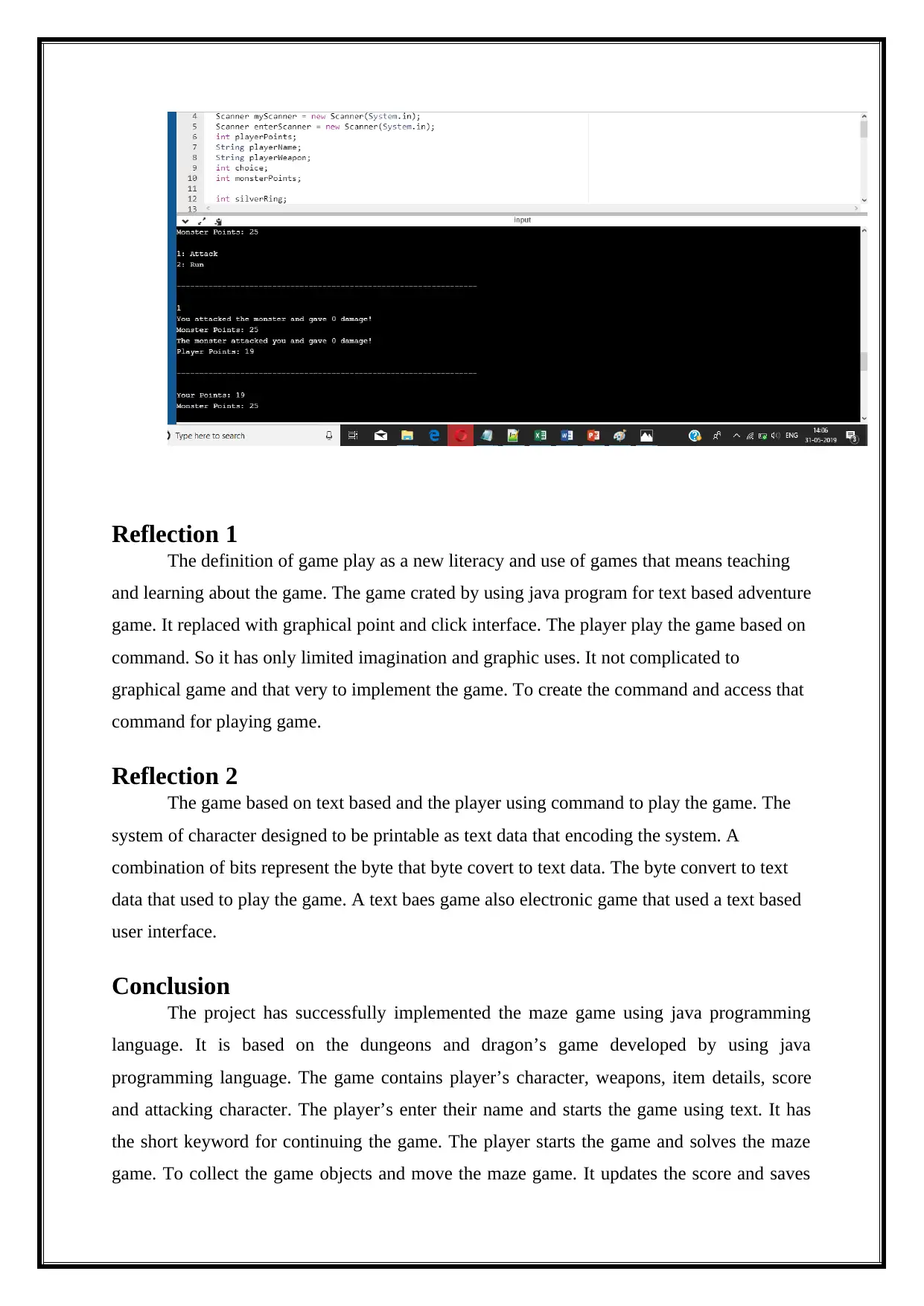
Reflection 1
The definition of game play as a new literacy and use of games that means teaching
and learning about the game. The game crated by using java program for text based adventure
game. It replaced with graphical point and click interface. The player play the game based on
command. So it has only limited imagination and graphic uses. It not complicated to
graphical game and that very to implement the game. To create the command and access that
command for playing game.
Reflection 2
The game based on text based and the player using command to play the game. The
system of character designed to be printable as text data that encoding the system. A
combination of bits represent the byte that byte covert to text data. The byte convert to text
data that used to play the game. A text baes game also electronic game that used a text based
user interface.
Conclusion
The project has successfully implemented the maze game using java programming
language. It is based on the dungeons and dragon’s game developed by using java
programming language. The game contains player’s character, weapons, item details, score
and attacking character. The player’s enter their name and starts the game using text. It has
the short keyword for continuing the game. The player starts the game and solves the maze
game. To collect the game objects and move the maze game. It updates the score and saves
The definition of game play as a new literacy and use of games that means teaching
and learning about the game. The game crated by using java program for text based adventure
game. It replaced with graphical point and click interface. The player play the game based on
command. So it has only limited imagination and graphic uses. It not complicated to
graphical game and that very to implement the game. To create the command and access that
command for playing game.
Reflection 2
The game based on text based and the player using command to play the game. The
system of character designed to be printable as text data that encoding the system. A
combination of bits represent the byte that byte covert to text data. The byte convert to text
data that used to play the game. A text baes game also electronic game that used a text based
user interface.
Conclusion
The project has successfully implemented the maze game using java programming
language. It is based on the dungeons and dragon’s game developed by using java
programming language. The game contains player’s character, weapons, item details, score
and attacking character. The player’s enter their name and starts the game using text. It has
the short keyword for continuing the game. The player starts the game and solves the maze
game. To collect the game objects and move the maze game. It updates the score and saves
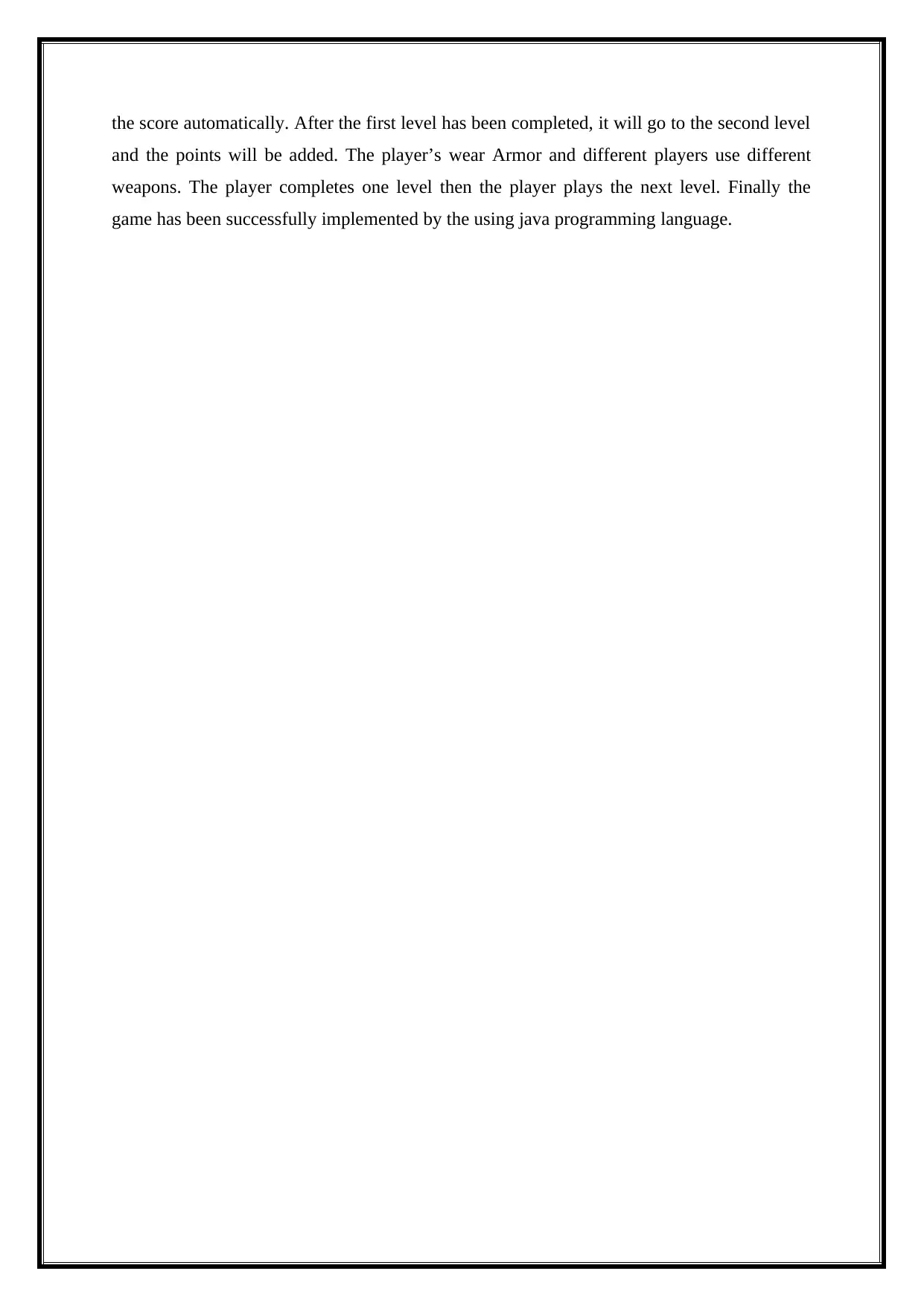
the score automatically. After the first level has been completed, it will go to the second level
and the points will be added. The player’s wear Armor and different players use different
weapons. The player completes one level then the player plays the next level. Finally the
game has been successfully implemented by the using java programming language.
and the points will be added. The player’s wear Armor and different players use different
weapons. The player completes one level then the player plays the next level. Finally the
game has been successfully implemented by the using java programming language.
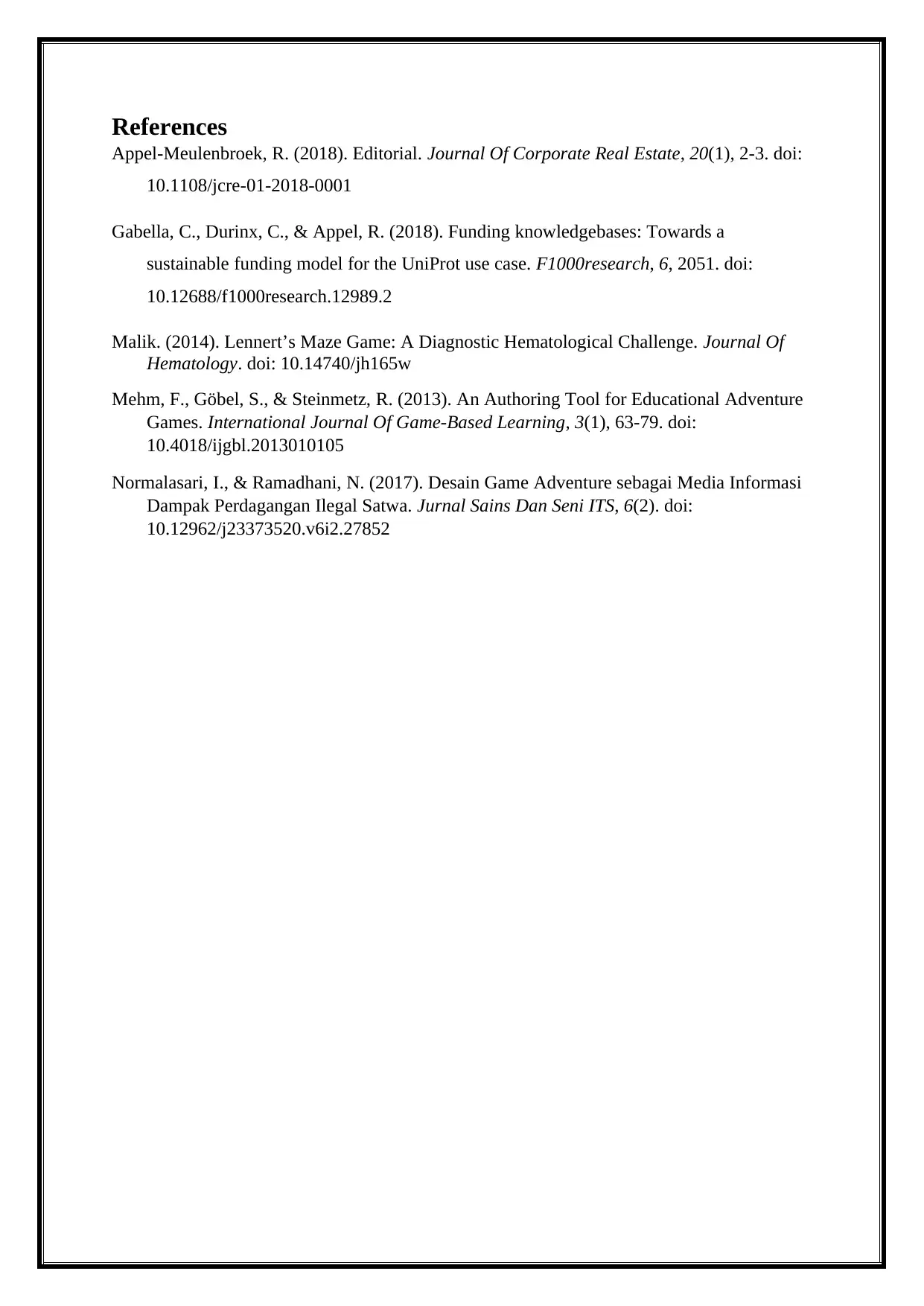
References
Appel-Meulenbroek, R. (2018). Editorial. Journal Of Corporate Real Estate, 20(1), 2-3. doi:
10.1108/jcre-01-2018-0001
Gabella, C., Durinx, C., & Appel, R. (2018). Funding knowledgebases: Towards a
sustainable funding model for the UniProt use case. F1000research, 6, 2051. doi:
10.12688/f1000research.12989.2
Malik. (2014). Lennert’s Maze Game: A Diagnostic Hematological Challenge. Journal Of
Hematology. doi: 10.14740/jh165w
Mehm, F., Göbel, S., & Steinmetz, R. (2013). An Authoring Tool for Educational Adventure
Games. International Journal Of Game-Based Learning, 3(1), 63-79. doi:
10.4018/ijgbl.2013010105
Normalasari, I., & Ramadhani, N. (2017). Desain Game Adventure sebagai Media Informasi
Dampak Perdagangan Ilegal Satwa. Jurnal Sains Dan Seni ITS, 6(2). doi:
10.12962/j23373520.v6i2.27852
Appel-Meulenbroek, R. (2018). Editorial. Journal Of Corporate Real Estate, 20(1), 2-3. doi:
10.1108/jcre-01-2018-0001
Gabella, C., Durinx, C., & Appel, R. (2018). Funding knowledgebases: Towards a
sustainable funding model for the UniProt use case. F1000research, 6, 2051. doi:
10.12688/f1000research.12989.2
Malik. (2014). Lennert’s Maze Game: A Diagnostic Hematological Challenge. Journal Of
Hematology. doi: 10.14740/jh165w
Mehm, F., Göbel, S., & Steinmetz, R. (2013). An Authoring Tool for Educational Adventure
Games. International Journal Of Game-Based Learning, 3(1), 63-79. doi:
10.4018/ijgbl.2013010105
Normalasari, I., & Ramadhani, N. (2017). Desain Game Adventure sebagai Media Informasi
Dampak Perdagangan Ilegal Satwa. Jurnal Sains Dan Seni ITS, 6(2). doi:
10.12962/j23373520.v6i2.27852
1 out of 19
Related Documents
Your All-in-One AI-Powered Toolkit for Academic Success.
+13062052269
info@desklib.com
Available 24*7 on WhatsApp / Email
![[object Object]](/_next/static/media/star-bottom.7253800d.svg)
Unlock your academic potential
© 2024 | Zucol Services PVT LTD | All rights reserved.




